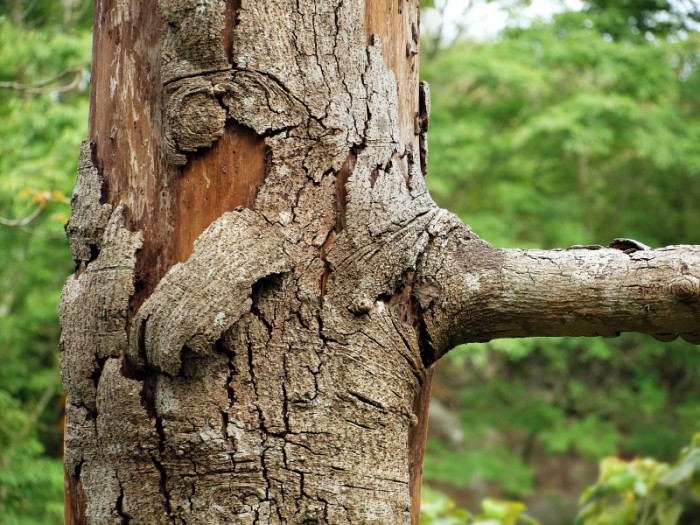
Nothing is more horrific to any gardener, hobbyist or professional, than seeing a beloved tree dying from disease. Trees can become infected with disease, just like people and animals, and there are many different bacterial and fungal infections from which the trees might suffer. Tree disease is caused by varying factors, including the tree’s geographical location, weather, soil conditions, and the overall health of the tree and other plant life surrounding it. Where a person lives and plants a tree, will dictate the tree diseases that one should worry about.
If caught in time, tree disease is not necessarily a death sentence. Many diseases can be treated by the grower once the specific bacterial or fungal culprit is identified. In worse case scenarios, professionals can be brought in to cure the tree or remove it completely, if it is too late to save the plant. Diseases can also be avoided by knowing the common types prevalent in the geographic area, and purchasing and planting trees resistant to the area’s problematic agricultural disease. Diligently monitoring the tree’s fertilizer, light, soil, and watering conditions will also help keep disease at bay.
Canker Disease
- Canker tree disease comes in three common forms, Cytospora, Nectria, and Phomopsis, and resembles a blister on the tree’s bark or branch much like a canker sore.
- Cytospora canker commonly infects pine, poplar, spruce, and willow trees; Nectria canker is known to infect honey locust, maple, and oak trees; Phomopsis canker might attack arborvitae, Douglas fir, juniper, and Russian olive trees.
- Canker tree disease is caused by an open wound on the tree’s branches that has become infected with one of dozens of bacteria or fungus of numerous classifications.
Heart Rot Disease
- Heart rot tree disease can infect many deciduous trees, such as beech, birch, cedar, dogwood, and maple trees, that are improperly pruned, left with broken branches, or damaged by fire, insects, or animals.
- Much like canker disease, heart rot tree disease is also caused by several species of fungus, such as the Fistulina hepatica, that has grown on the tree’s open wound or bare wood.
- Tree growers suspecting heart rot infection should look for conk or mushroom bodies growing on the tree, as these are true sign of the presence of fungus.
Powdery Mildew Disease
- Catalpa, chokeberry, crabapple, and linden trees are most likely to suffer powdery mildew disease, although the mildew is known to attack nearly all vegetation in the right conditions.
- Tree growers noticing a white or gray powdery growth resembling talcum powder on the leaves of their trees might have a powdery mildew problem.
- Powdery mildew is most common in warm, dry climates, and the fungi responsible for powdery mildew are of the Erysiphale classification.
Root and Butt Rot Disease
- Three forms of root and butt rot disease – Armillaria, Hypoxylon deustum, and black root rot – can infect hardwood trees at their roots and butt, which is the base of the tree’s trunk at ground level.
- Armillaria attacks the roots and butts of weakened conifer and broad-leaved trees; Hypoxylon deustum attacks tree roots and butts through mechanical wounds on hardwood trees; black root rot decays the roots of stressed hardwoods.
- Root and butt rot disease is a black, leathery fungus, such as the viral Serpula himantioides fungus, that spreads up the tree’s trunk from the ground; mushrooms might also be present growing in the soil at the base of the tree.
Sooty Mold Disease
- Boxelder, elm, linden, and maples are most likely susceptible to sooty mold tree disease, although the disease is known to attack several species of trees where a feeding insect population is prevalent.
- The sooty mold fungus – which includes molds of the Antennariella, Aureobasidium, Capnodium, Cladosporium, Limacinula, and Scorias varieties – feeds off the insect honeydew and is a black, powdery coating found on the tree’s leaves and surrounding soil.
Verticillium Wilt Disease
- Verticillium alboatrum, or Verticillium wilt, is a soil-borne disease that is known to most commonly attack catalpa, elm, maple, and stone fruit trees.
- The disease is particularly problematic because it infects the tree via its root system, causing the tree leaves to turn a lighter color, look somewhat disheveled, and eventually wilt and drop from the branches.
- Verticillium wilt is a highly contagious tree disease, as the fungus, all of the Verticillium genus classification, can spread quickly through the soil to other garden life.
